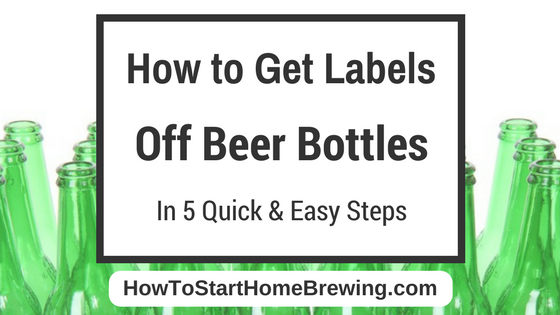When I first got into homebrewing, I recycled a lot of beer bottles. Anytime I’d buy a 6-pack at the store, my collection would grow. Then it came time to de-label all of those precious bottles.
I wasted a lot of time trying several things:
- Soaking bottles in water and tearing labels off, leaving behind plenty of sticky (and undisturbed) residue.
- Using soap/water – still had the same problem.
- Scraping, scratching, rubbing, twisting. You name it, I did it and still, gunk was nearly impossible to get off.
It was frustrating. I wanted nice, clean bottles with no labels.
Could I have bought them new? Sure, but I was new to the game and on a budget.
That’s when I found out the standard method of cleaning and de-labeling beer bottles from other fellow homebrewers.
Not only does it save money – it saves time!
How to Get Labels Off Beer Bottles
Disclaimer: While this typically works for most bottles with paper/glue labeling, there will be some bottles that fight back. It’s to be expected. Every brand is different and some come off better than others.
For bottles that have a vinyl or laminated label, make sure to peel off the label first before following the steps below. If not, you will end up with a slippery mess on your hands.
Step 1 – Fill Up Kitchen Sink with Water and OxiClean™
When it comes to getting labels off of beer bottles, OxiClean™ is a homebrewer’s secret weapon.
Whoever thought that something used for stain removal would be ideal for removing paper labels? It might sound silly, but it will flat out make your life easier!
To get started, you will need to pick up the standard OxiClean™ from any retail outlet near you (or online). I have found that some “knock off” brands that use a similar formula will also work just fine.
Once you get your OxiClean™, fill up your sink halfway with warm water and add a scoop of OxiClean™. Toss on a pair of kitchen gloves and mix the solution in the water until it’s dissolved completely.
Step 2 – Place Bottles into Sink and Let Soak for an Hour
Hopefully your bottles are sitting close by. If not, it’s time to round them up!
The size of your sink will determine how many bottles you can fit in at a time. Depending on how many bottles you have to de-label, this may be a fairly quick or lengthy process.
In order to get as many bottles submerged and properly fit, I dunk each one until they are completely filled up with water. Doing this will help you fit the maximum amount of bottles your sink will allow.
Once all of your bottles are in the submerged in the solution, set a timer for 60 minutes and find something to do (like popping the top off a nice, cold homebrewed beer).
Step 3 – Peel Away Labels
And now the fun begins…
Warning: This is the part where things can get pretty messy. Some labels will nearly slip off in one piece. Others will tend to require a little more elbow grease.
If you’re not careful during this step, you’ll end up with a sink full of wet paper. Let that crap slide down your drain and you could be dealing with a bigger headache down the road.
To help make alleviate a sticky mess and future plumbing problems, this is what I do:
- Pull out a few plastic grocery store bags and place one on the counter (next to my sink).
- Remove a bottle from the sink and place it over the plastic bag.
- Peel off the label and allow it to fall directly into the bag.
- Place the bottle back into the solution, remove another bottle and continue the same process until all bottles have no labels.
Once you get through a round or two of this, you’ll find out that it’s not too bad. Tedious, yes, but not terrible.
Step 4 – Remove Any Residual Glue with Sponge or Stainless Steel Pad
Now that your bottles are label-free, you still might notice some extra glue or label remnants left behind. This is actually very common and almost expected.
As I mentioned previously, every company uses different labels and adhesive.
Removing extra glue is a fairly simple process. Since your bottles have been soaking in the OxiClean™ solution for some time, most of the glue left behind can be easily scraped off.
To do this, I suggest using either of the following:
- A sponge with a “scrubbing edge” (a rough side used specifically for scrubbing off grime and hard-to-remove food particles on dishes, for example).
- A stainless steel pad
Remove a bottle from the sink and using either of the two items listed above, gently scrub the affected area. As you scrub, you will notice the glue starting to break apart.
Once all of the glue is broken apart, run your bottle under warm water to rinse it off completely. Using a hand towel, pat the bottle dry and place it to the side. Continue this process until you’ve ran through your entire batch of bottles.
One thing to note: Unless you’re de-labling hundreds of bottles per day, having glue particles run down your drain isn’t going to cause serious harm. It’s a VERY small amount and is essentially dissolved by the time it’s rinsed off of your bottle.
Step 5 – Run Bottles Through a Cycle in Dishwasher (without Soap)
If you made it this far – congratulations! You’re a bottle de-labeling expert.
While this step is pretty self-explanatory, it’s definitely something I highly recommend (if you have a dishwasher, that is).
If you do not have a dishwasher, a nice rinse under warm water (which should’ve been done in the step above) is really all you need.
What I do like about running these bottles through a quick cycle with no soap and heat dry is that it gives you a nice, clean bottle.
Seriously – the things look practically brand spanking new after a wash and heat cycle!
Once you end up with a clean bottle, you have two options:
- You can keep them that way.
- You could be like other homebrewers and create custom labels for your beer, truly making it your own.
Regardless of what you decide to do, you now have bottles that should get you through plenty of batches of beer.
if you ask me, I’d say that’s pretty damn cool!
No More Struggling to Remove Labels Again
That’s right – No longer do you have to wonder how to get labels off beer bottles !
Instead, you have a surefire method that has been proven time and time again. It’s cheap and easy, but does require a bit of your time and effort.
When you think about the money you can save though, the process makes it worthwhile.
As they always say, “Relax, don’t worry, have a homebrew!”

